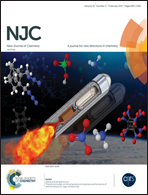Fine tuning of compact ZnO blocking layers for enhanced photovoltaic performance in ZnO based DSSCs: a detailed insight using β recombination, EIS, OCVD and IMVS techniques†
Abstract
The electron–hole recombination and back electron flow at the conducting oxide–mesoporous film interface in dye-sensitized solar cells (DSSCs) are addressed primarily by the use of pre-blocking layers. Herein, the effects of zinc oxide (ZnO) blocking layers (BLs) on the photovoltaic performance of ZnO based DSSCs are investigated in detail using electrochemical impedance spectroscopy (EIS), open circuit voltage decay (OCVD) and intensity modulated photovoltage spectroscopic (IMVS) techniques. BLs of varying thicknesses obtained by a low temperature solution process provided uniform surface coverage of nanosized ZnO particles over FTO. Devices with optimized ZnO blocking layer thickness (12 nm) lead to improved performance (efficiency 2.57%) in comparison to the devices fabricated using bare FTO (1.27%) by suppressing interfacial recombination at the FTO/ZnO interface thereby improving the lifetime leading to better performance.



 Please wait while we load your content...
Please wait while we load your content...